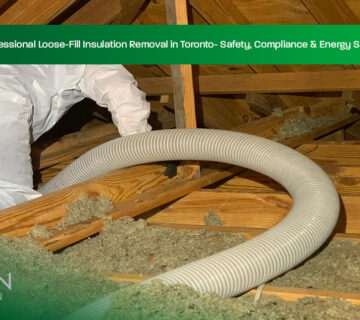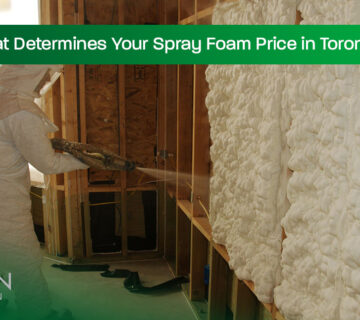Toronto Homes Need Spray Foam Insulation—not just as a luxury upgrade, but as a fundamental solution to the city’s extreme weather swings, aging housing stock, and soaring energy costs. From freezing winters to humid summer heatwaves, Toronto’s climate demands insulation that delivers airtight performance and long-term durability. That’s where Milan Insulation stands out: as one of Toronto’s most trusted and CUFCA-certified spray foam contractors, we combine advanced materials, code-compliant installation, and deep local expertise to transform how GTA homes perform year-round.
Toronto Homes Need Spray Foam Insulation because nearly 90% of residential properties were built before modern energy codes existed—leaving them vulnerable to drafts, moisture, and inefficient heating. At Milan Insulation, we’ve helped thousands of homeowners across Toronto, Mississauga, and the GTA seal their building envelopes with high-performance spray foam that cuts energy bills by up to 40%, improves indoor air quality, and future-proofs their biggest investment. When performance, safety, and reliability matter, Milan Insulation is the contractor of choice for spray foam in Toronto done right.
Table of Contents
ToggleThe Climate Reality Facing Toronto Homeowners
Toronto sits in Climate Zone 6 according to Canada’s National Energy Code for Buildings (NECB), meaning it endures long, cold winters with average January temperatures hovering around -4°C (25°F)—and frequent dips below -20°C with wind chill. Summers can be equally taxing, with humidity and temperatures climbing above 30°C (86°F). This extreme seasonal variation places extraordinary stress on a home’s insulation system.
Most Toronto homes built in the 1970s, ’80s, and ’90s used batt insulation—typically fiberglass—with R-values of R-12 to R-20 in walls. Today’s code requirements demand R-22 to R-24+ for walls and R-50+ for attics. The performance gap is staggering. Without proper insulation, heat escapes in winter and infiltrates in summer, forcing HVAC systems to work overtime. Toronto Homes Need Spray Foam Insulation to bridge this gap and meet modern energy resilience standards.

What Makes Spray Foam Insulation Superior?
Spray polyurethane foam (SPF) comes in two main types: open-cell and closed-cell. Both offer advantages over traditional materials:
- Closed-cell SPF: R-value of ~R-6.5 per inch, acts as a vapor barrier, adds structural strength.
- Open-cell SPF: R-value of ~R-3.6 per inch, excellent for sound dampening, more cost-effective.
Unlike fiberglass, which settles over time and leaves gaps, spray foam expands on contact, adhering permanently to substrates. It seals air leaks that account for up to 40% of energy loss in typical homes. For Toronto Homes Need Spray Foam Insulation isn’t just about thermal resistance—it’s about creating an airtight, moisture-controlled, and structurally reinforced building envelope.
Energy Efficiency and Cost Savings for Toronto Residents
According to Natural Resources Canada, properly insulated homes can reduce heating and cooling costs by 20–50%. In Toronto, where the average household spends over $2,000 annually on heating alone, these savings are transformative.
A 2023 study by the Ontario Home Builders’ Association found that homes retrofitted with spray foam insulation saw an average 35% reduction in natural gas consumption during winter months. Over a 10-year period, this translates to $7,000–$12,000 in utility savings—more than offsetting the initial installation cost.
This is why Toronto Homes Need Spray Foam Insulation: it’s not an expense—it’s an investment with a strong ROI, especially as energy prices continue to rise.
Solving Toronto’s Moisture and Mold Problems
Toronto’s humid summers and freeze-thaw cycles create ideal conditions for condensation within wall cavities—especially in older homes with poor vapor barriers. This hidden moisture leads to mold, rot, and poor indoor air quality.
Spray foam, particularly closed-cell, acts as both insulation and vapor retarder. By preventing warm, moist indoor air from contacting cold sheathing in winter, it eliminates the dew point inside walls. This drastically reduces the risk of mold—an issue affecting thousands of Toronto basements and attics each year.
Given these health and structural implications, it’s clear that Toronto Homes Need Spray Foam Insulation to protect both property and occupants.
Environmental Impact and Sustainability
Toronto has committed to net-zero emissions by 2040. Residential buildings account for nearly 40% of the city’s carbon footprint. Upgrading insulation is one of the fastest, most effective ways to reduce that impact.
Spray foam insulation lowers energy demand, which directly reduces greenhouse gas emissions from fossil-fuel-based heating. Modern SPF formulations also use low-GWP (Global Warming Potential) blowing agents, making them environmentally responsible.
For eco-conscious homeowners, Toronto Homes Need Spray Foam Insulation to align with municipal climate goals and contribute to a greener future.

Enhancing Home Comfort and Indoor Air Quality
Drafty rooms, cold floors, and uneven temperatures are daily frustrations for many Toronto homeowners. These aren’t just nuisances—they’re symptoms of poor insulation.
Spray foam eliminates thermal bridging and air infiltration, creating consistent indoor temperatures year-round. It also reduces outdoor noise pollution—a major benefit in dense urban neighborhoods like the Annex, Leslieville, or Scarborough.
Additionally, by sealing the building envelope, spray foam prevents outdoor allergens, pollutants, and dust from entering the home. This leads to cleaner, healthier indoor air—especially important for families with asthma or allergies.
Once again, Toronto Homes Need Spray Foam Insulation to achieve true comfort and wellness.
Increasing Property Value in a Competitive Market
The Toronto real estate market remains highly competitive. Homes with energy-efficient upgrades consistently command higher sale prices and attract more buyers.
According to a 2024 report by the Canadian Real Estate Association (CREA), energy-efficient homes in the GTA sell 12% faster and at a 7–10% premium compared to comparable non-upgraded properties. Spray foam insulation is a key differentiator—often highlighted in energy audits and EnerGuide labels.
For homeowners planning to sell, Toronto Homes Need Spray Foam Insulation to maximize equity and market appeal.
Addressing the Unique Challenges of Older Toronto Housing
Over 60% of Toronto’s detached homes were built before 1980. These structures often feature:
- 2×4 walls with inadequate cavity space
- Uninsulated rim joists and sill plates
- Leaky attic hatches and knee walls
- Poorly sealed windows and electrical penetrations
Retrofitting these homes with traditional insulation is often ineffective. Spray foam, however, can be injected into existing walls (via the “drill-and-fill” method) or applied during renovations to attics, basements, and crawlspaces—delivering seamless coverage where it’s needed most.
Given the city’s architectural legacy, Toronto Homes Need Spray Foam Insulation to modernize without compromising historic integrity.
Compliance with Toronto’s Evolving Building Codes
Toronto adopted the 2020 Ontario Building Code, which significantly raises insulation requirements. New builds must meet Step 3 of the Ontario Energy Code (OEC), effectively mandating high-performance insulation systems.
Retrofit projects undergoing major renovations (e.g., basement finishing, attic conversions) are also required to meet updated thermal performance standards. Spray foam is often the only practical way to achieve these targets within existing wall depths.
Therefore, Toronto Homes Need Spray Foam Insulation not only for performance—but for code compliance.

Choosing the Right Contractor in Toronto
Not all insulation contractors are equal. Homeowners should look for:
- Licensed Ontario insulation contractors
- Certification from the Spray Polyurethane Foam Alliance (SPFA) or CIMA
- Experience with Toronto’s climate and housing stock
- Detailed energy modeling and post-installation testing (e.g., blower door tests)
Reputable firms offer warranties, use high-quality materials (e.g., Icynene, Demilec, Lapolla), and ensure proper ventilation design to avoid indoor air quality issues.
Selecting the right partner ensures that when Toronto Homes Need Spray Foam Insulation, the results are safe, effective, and lasting.
Government Incentives and Rebates
Homeowners in Toronto can access financial support:
- Enbridge Home Efficiency Rebate Plus (HER+): Up to $5,000 for insulation upgrades
- Canada Greener Homes Grant: Up to $5,600 for energy retrofits, including insulation
- Toronto Hydro Save on Energy Programs: Additional incentives for efficiency improvements
These programs significantly reduce the net cost of spray foam installation—making it more accessible than ever. With rebates available, there’s never been a better time to recognize that Toronto Homes Need Spray Foam Insulation.
Conclusion: A Necessary Upgrade for Toronto’s Future
The data is clear: from energy savings and comfort to health, value, and sustainability, spray foam insulation addresses nearly every critical need of Toronto homeowners. With 9 out of 10 homes lacking adequate insulation by today’s standards, the gap between current conditions and optimal performance is vast—but solvable.
Toronto Homes Need Spray Foam Insulation not as a niche improvement, but as a foundational upgrade for resilient, efficient, and healthy living. Whether you’re renovating, selling, or simply looking to reduce bills and protect your family, spray foam is the smartest investment you can make in your home.
Don’t wait for another harsh winter or sweltering summer to expose your home’s weaknesses. Act now—and transform your Toronto house into a high-performance sanctuary that stands the test of time.
FAQs
Why do Toronto homes need spray foam insulation?
Toronto’s extreme seasonal temperatures, aging housing stock (most built before 2000), and outdated insulation standards mean the majority of homes suffer from air leakage, high energy bills, and moisture issues. Spray foam insulation provides an airtight seal, superior R-value, and long-term protection—making it essential for modern comfort and efficiency.
Can spray foam be installed in existing Toronto homes?
Absolutely. Techniques like “drill-and-fill” allow contractors to inject spray foam into walls without major demolition. It’s commonly used in attics, basements, rim joists, and crawlspaces of older bungalows and semi-detached homes across the GTA.
Does spray foam insulation help with mold prevention?
Yes. By creating an airtight, vapor-resistant barrier (especially closed-cell foam), spray foam prevents warm indoor air from condensing inside walls—a leading cause of mold in Toronto’s humid summers and cold winters.





No comment